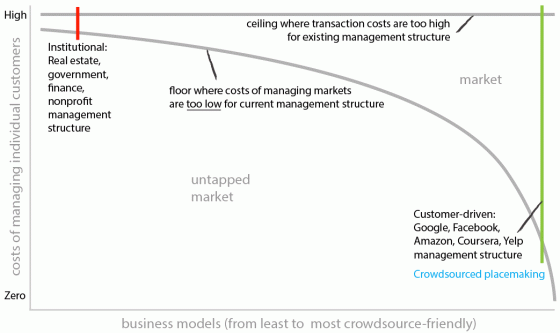Why placemaking isn’t crowdsourced… yet

It may be easier to explain via diagram why the content of wildly successful services like Facebook, Google, eBay and Amazon are sourced by crowds, yet placemaking isn’t.
Based on economic models presented in crowdsourcing expert Clay Shirky’s , the key to whether or not an entity will crowdsource is based on its management and management structure.
On the x-axis, all business models are represented, from the least crowdsource-friendly to the most. On the y-axis are the costs of managing markets, in other words, the costs of identifying, building relationships with, growing, and maintaining customer bases. No business will survive if the costs of managing markets get too high, such as employees spending extensive face-to-face time with each and every customer.
However, the fork in the road between companies that are growing in an evolving economy and those that aren’t, lies in what happens when the costs of managing markets gets too low. That is, when just the opposite of extensive employee-customer relationship building time is spent, but rather ever decreasing employee time spent managing an ever increasing amount of time spent between customers building relationships with one another.
Why won’t certain businesses, and industries, embrace this? Because they want to maintain full control of the content, as is notorious in real estate. Notice the narrow range (red line) of high costs real estate development firms insist on sticking to, which thus leaves a vast untapped market behind. Our modern built environment reflects this – it literally looks like it was developed by a handful of people with the same ideas, and it was. Not so with the fastest growing companies whose management structure is designed to allow more and more user-created input, content and participation… amongst themselves… and it shows.
Hope is on the way, when crowdsourced placemaking becomes the norm, and it will, starting with projects with management structures represented on the far right end of the diagram. Stay tuned to hear more from Renaissance Downtowns in New England and Red Dove in Washington DC, or go here to get started yourself.






Leave a Reply